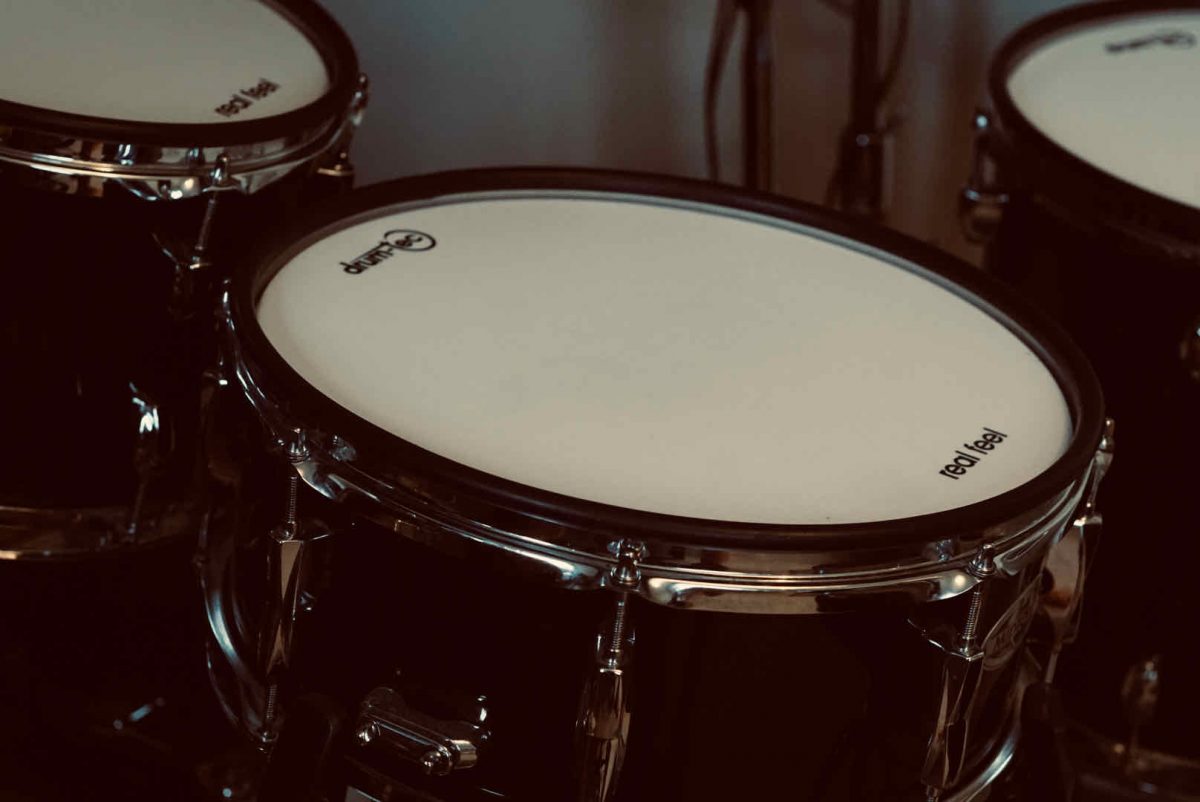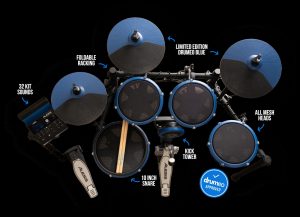There are a few ways you can go about making your electronic drums sound better:
- Playing back through quality headphones
- Editing the sounds in your drum module
- Using 3rd party drum module presets
- Connecting your eDrums to a computer and using a VST drum plugin
Below, we’ll delve deeper into each of these concepts, so you can find the right solution that works for you!
Should you use headphones when playing electronic drums?
Starting with the most basic way to make your eDrums sound better, the way you monitor your drums will have an impact on how they sound.
If you have your electronic drums plugged into speakers, then they will need to be loud enough to overcome the sound of your sticks striking the drum and cymbal pads. You may find that you need the volume turned up quite high for this, and even then, you’ll still be able to hear the actual acoustic sound of the drums being struck, which means you’re not hearing the drum sounds from the module as clearly.
A better solution could be to try using headphones, which is what I prefer personally. The headphones themselves are acting as a barrier to isolate the drum module sounds from the acoustic noise striking the drum pads. That means you’re hearing more of the module’s sound with less of the background noise mixed in.
Taking this further, the type of headphones make a difference to the way your electronic drums sound. To put it simply, quality headphones will sound better than cheaper headphones.
You may want to consider in-ear headphones or professional in-ear monitors to help muffle out the background noise more effectively. Alternatively, a pair of over-ear headphones can also be a good solution for muffling out background noise.
You may also be thinking about headphones with Active Noise Cancellation (ANC), but unfortunately, these don’t really work well in muffling out eDrums. Noise-cancelling headphones are more suited to continuous background noise, such as engine noise on a plane, and aren’t suitable for short, sharp sounds like striking a mesh drum head or rubber cymbal pad.
Make your drum module sounds better by editing them
As you might expect, the drum module itself plays an important role in how your electronic drums sound and can be edited to make them sound better.
You might be tempted to upgrade your module to a more expensive one, which typically will have more realistic-sounding drums built-in. But if you don’t have the budget for this, then there are still things you can do with your existing module.
Unless you have one of the most basic drum kits, your drum module will include options to edit the built-in drum sounds. That can vary from adding effects like reverb to making your drums sound like they’re in a giant concert hall or in a small room, and go deeper into individual settings for each part of your kit.
On Roland drums, for example, there is the ability to change the size, tuning, and even material of your drums. Of course, this is all simulated and is possible because Roland drum sounds are computer-generated.
Some Roland modules including the TD-07, TD-17, TD-27, TD-30, TD-50 also feature a three-band EQ. This can be used to cut or boost certain frequencies on each drum or cymbal to make the preset sound more realistic.
Below is a great video from The eDrum Workshop explaining how to do this:
Layering drum samples
Some drum modules such as the Roland TD-17, TD-27 and TD-50 allow users to load their own samples into their drum module for specific instruments and play them back when the pad is struck. These samples can usually be mixed into your module’s built-in sounds and can make your drum sound fuller.
A drum sample is a short piece of audio playing back the sound of a drum being hit, that is cropped to start immediately as the drum is struck.
The drum modules mentioned above use ‘one-shot samples’, which means only one sound file can be triggered on a specific drum. Why does this matter?
If you imagine playing a real drum, you are likely to hit the drum slightly differently each time, even if you’re very specific with where you strike it. This produces a slightly different sound on each hit. When used on its own, a one-shot sample can sound quite robotic if played multiple times, such as on a snare roll.
On top of that, the velocity or strength you hit the drum has an impact on the sound it makes – hitting an acoustic drum hard sounds different from playing it softly. With a one-shot sample, the only variable is the volume that which the sound file is played.
This is why drum samples sound best when layered into a built-in drum sound already on your module, and the volume can be tailored to blend in. That way, you can have the module sounds providing the ‘randomness’ to sound human, with the drum sample adding some extra punch.
Using 3rd party module presets to improve your eDrums
Does editing the sounds in your drum module sound a bit daunting? Fortunately, there are companies that can achieve all of the above for you. Many drum modules offer the ability to make custom presets, and even load new ones directly via USB. As a result, there are many companies that offer presets designed for specific drum modules.
A popular maker of eDrum presets is V Expressions, which supports a wide range of Roland modules, as well as the Pearl Mimic Pro. The eDrum Workshop also offers kit presets and samples for Roland, Pearl, Alesis and 2Box modules.
Expand your eDrums with VST Instruments
What if I told you you might already have a new drum module thousands of times more powerful than the one currently connected to your eDrum kit? If you have a desktop PC or laptop, then you already have the ingredients to make your electronic drums sound better.
What are VSTs and how do they work?
The solution is to use a VST instrument. VST stands for Virtual Studio Technology and is a type of software that allows virtual instruments and effects to be played on a computer via a DAW or Digital Audio Workstation application.
To put it in more simple terms, you can plug in your existing electronic drum module to your computer, and have the computer take over generating the drum sounds. Here’s what you’ll need:
- A Mac or Windows PC and an electronic drum kit
- A USB cable, if your module includes a USB interface
- A MIDI interface, if your module doesn’t have a USB interface
- A drum VST – check out our recommendations below
- A DAW to launch and play the VST using your drums
Popular drum VST plugins
There are several popular VST drum plugins out there, ranging from affordable entry-level options to high-end audio engineering tools used on commercial recordings. All are available on Windows and Mac.
What DAW should you use to play VST drums?
There’s no need to spend any money on a DAW if all you want to do is trigger drum samples! Here are four options:
- GarageBand (Free with Apple Macs)
- Reaper (Free on Windows & Mac)
- Kontakt Player (Recommended for Get Good Drums, Windows & Mac)
- Superior Drummer 3 (Windows & Mac No DAW needed!)
How to connect an electronic drum kit to a computer
All that remains is to connect your electronic drums to your PC. If your drum kit is up to around 5-7 years old, then it likely has a built-in USB interface. This makes connecting your drums nice and easy, just plug it in and install the drivers from your drum module manufacturer’s website.
If you have an older module without a USB connection, then your module may have a MIDI connection instead. You’ll need a MIDI interface or audio interface with a MIDI connection. These devices effectively act as a bridge between the MIDI interface of your module and your PC via USB.
The steps are similar – only you’ll need to install the interface’s drivers and connect to your PC with USB on one end and a MIDI cable to your module!
Wrapping up
As you’ve seen, there are several different ways to make your electronic drums sound better, some of which are simple and cheap, while others may cost a bit of money or are a bit more complex. All in all, rest assured there are ways to make your drums sound better without having to go out and buy a new electronic kit or drum module!
Don’t have a set of eDrums yet and want to go down the VST route? Check out our guide on the best drum modules for VSTs!




